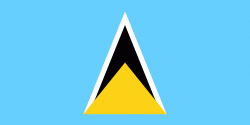Laborie
Laborie is a village on the south coast of Saint Lucia. It was originally called l'Islet a Caret after the Loggerhead sea turtles that were found in the area. The name Laborie is named after Baron de Laborie who was the French governor of Saint Lucia from 1784–1789. At that time the village had a population of 712. Laborie is the seat of the Laborie District.
The French introduced large estates to the island and after the British took control of the island in 1814, many French landowners remained on their estates.
In 1838 the first school was opened. Known as the "Mico School" because it was opened and operated by the Lady Mico Trust, it had 80 pupils and lasted until 1891. By this time a Catholic school had opened in the village.
In 1907, the 18th Century church was replaced by a larger church which opened in 1914.
During World War II, American forces opened a radar station on the hill of Morne le Blanc to help protect the airfield that is now Hewanorra International Airport. The remnants are still visible today.
The Creole heritage is still visible today, both in the local culture and in the Saint Lucian Creole French language that is still widely spoken.
The French introduced large estates to the island and after the British took control of the island in 1814, many French landowners remained on their estates.
In 1838 the first school was opened. Known as the "Mico School" because it was opened and operated by the Lady Mico Trust, it had 80 pupils and lasted until 1891. By this time a Catholic school had opened in the village.
In 1907, the 18th Century church was replaced by a larger church which opened in 1914.
During World War II, American forces opened a radar station on the hill of Morne le Blanc to help protect the airfield that is now Hewanorra International Airport. The remnants are still visible today.
The Creole heritage is still visible today, both in the local culture and in the Saint Lucian Creole French language that is still widely spoken.
Map - Laborie
Map
Country - Saint_Lucia
 |
 |
| Flag of Saint Lucia | |
The first proven inhabitants of the island, the Arawaks, are believed to have first settled in AD 200–400. Around 800 AD, the island would be taken over by the Kalinago. The French were the first Europeans to settle on the island, and they signed a treaty with the native Caribs in 1660. England took control of the island in 1663. In ensuing years, England and France fought 14 times for control of the island, and the rule of the island changed frequently. Eventually, the British took full control in 1814. Because the island switched so often between British and French control, Saint Lucia was also known as the "Helen of the West" after the Greek mythological character, Helen of Troy.
Currency / Language
| ISO | Currency | Symbol | Significant figures |
|---|---|---|---|
| XCD | East Caribbean dollar | $ | 2 |
| ISO | Language |
|---|---|
| EN | English language |















